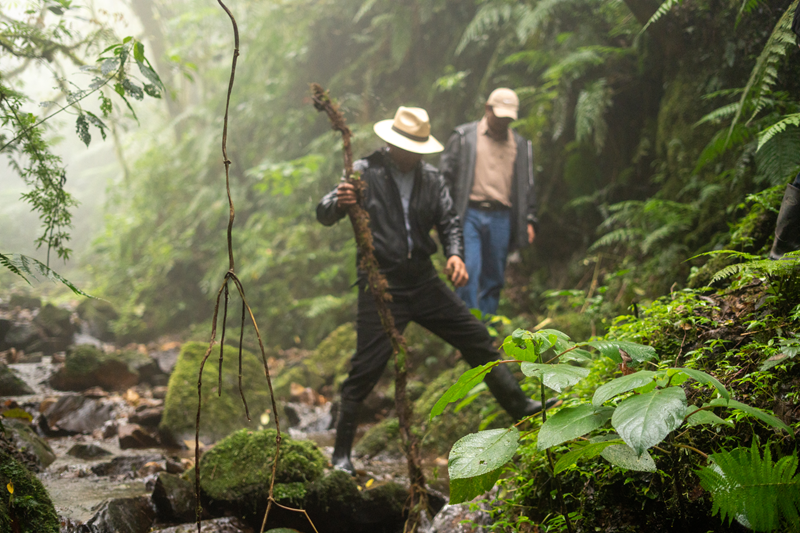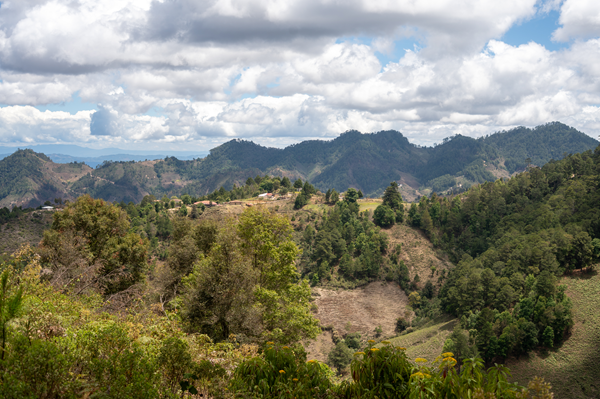Targeted management of invasive species could reduce EU…
12 June, 2025
Tuesday 03 june 2025
Header photo: AESMO team working within the reserve. All photos on this page: © Stephanie Broekarts / IUCN NL
In 1987, the Honduran government established the Güisayote Biological Reserve. Through a legislative decree published in the official governmental newspaper La Gaceta, and without prior free and informed consultation with municipalities and communities, a new protected area of 14,081.80 hectares was created. ‘Like most national protected areas, it became a “paper park”. Life inside the reserve continued as usual: people continued to farm, deforest, and expand the agricultural frontier,’ says Saravia.
In 1990, just three years after the reserve was established, AESMO began organising activities to raise awareness among local people about the area’s important biodiversity. At a later stage, agroforestry and beekeeping with native stingless bees were added to the NGO’s work.
In 2006, a unique opportunity arose when a local farmer offered to sell a property in the core area of the Güisayote Biological Reserve. This part of the reserve was – and still is – crucial for the water supplies of several communities in the area.
Text continues below the photos.


When Saravia learnt about the Land Acquisition Fund, AESMO took the opportunity. ‘We had to put together a funding proposal rather quickly, we did not have much time, but the Fund believed it in us,’ he explains.
The grant allowed AESMO to purchase almost 100 hectares of tropical cloud forest in the Güisayote Biological Reserve. The impact, however, was even bigger, according to Saravia: ‘It was a turning point. It was the first purchase in this part of the TRIFINIO region; the plans we had been developing for a while, became reality.’ Numerous land acquisition projects funded by various donors, including World Land Trust, expanded the reserve in the following years. From a “paper park’, the Güisayote Biological Reserve became a well-managed reserve with a unique co-management model.
‘At the national level, we are still losing forest, but here we are gaining forest cover: land that until a few years ago was destined for cattle grazing is now protected forest undergoing natural restoration.’
- Victor Saravia, director of AESMO
AESMO’s management approach changed over time. ‘Initially, the municipalities were the formal owners through public deeds containing clauses prohibiting the purchased land from being sold, leased, mortgaged, donated, exchanged, transferred, divided, or subjected to mining or other forms of exploitation. The NGO took charge of managing the reserve from the outset, with the support of forest rangers. Their salaries were paid by the municipalities in whose name the purchased properties were registered,’ Saravia explains.
The communities participated from the start, by providing matching funds, but it was not enough. ‘After a while, we began to realise that we had to do things differently. As the municipalities were the formal owners of the protected area, the land purchased basically remained in the hands of the government. Although we had public deeds with ironclad clauses, governments change every few years. With billions in silver and other minerals in the land, it was a risk,’ he says. AESMO developed the idea of creating a “Consejo Comanejante de Microcuenca” (Micro-Watershed Co-Management Council).
This Council is made up of Honduran organisations: community water management boards, community trusts, cooperatives, private companies, municipalities, and AESMO. On behalf of them, the land purchased for conservation is now legalised under a joint ownership legal framework whereby all parties own all the land regardless of the amount contributed, while maintaining the aforementioned unalterable clauses.
Text continues below the photos.


Today, AESMO operates under this unique model of shared governance, which has been fundamental to the success of its conservation efforts. It has become an example in Honduras, Latin America, and beyond. In addition to AESMO and municipal rangers, community members now also participate in patrols and monitoring on their land.
‘These people, often humble farmers, protect what belongs to them; they are committed,’ continues the Director. ‘As they patrol, they see where the water comes from and end up falling in love with the flora and fauna. They begin to think of water as part of something bigger connecting flora, fauna, soil, biodiversity, and people. AESMO believes in people’s ability and intelligence to contribute to improving their living conditions by applying the Kaizen approach. We do not create dependency or paternalism, which are so damaging to these countries. With our approach, people have a say, contribute funds for conservation, make decisions democratically and transparently, and feel proud of what they do.’
According to Saravia, the impact of active cloud forest protection became apparent after several years. ‘After six or seven years, communities noticed changes in the micro-watersheds: the flow of rivers originating on the purchased land began to increase. People were excited to see with their own eyes that conservation really works. Now we have much more water of better quality, which is also spreading to other areas.’
Experiencing this success, more and more people are joining the initiative. ‘We now have contributions from coffee cooperatives and savings and credit cooperatives, as well as from individuals in Honduras and other countries. We have been building this together,’ he continues enthusiastically. ‘At the national level, we are still losing forest, but here we are gaining forest cover: land that until a few years ago was destined for cattle grazing is now protected forest undergoing natural restoration.’
Text continues below the photos.


Multiple plots of land now managed by AESMO were largely deforested when they were purchased. Wildlife was severely affected because their habitat was destroyed. According to Saravia, the reserve’s impact is also visible in terms of biodiversity. ‘I see species such as the quetzal and the peccary returning to the area. Just yesterday, I saw a short video of a peccary (Tayassu pecari), which is endangered, captured by a camera trap. We also have populations of the highland guan (Penelopina nigra), which has “vulnerable” status according to the IUCN Red List.’
‘In Honduras, we work with a wide range of stakeholders: civil society, young people, the elderly, women, and children. Everyone has a place here; it is the people who make it possible. ’
- Victor Saravia, director of AESMO
Together with local communities, AESMO currently manages more than 2,000 hectares purchased for biodiversity, water, and soil conservation. Despite the significant progress made by the NGO thanks to its perseverance, ambition, and determination, its mission is not yet fulfilled, according to Saravia. ‘Our dream is to establish a reserve stretching from Cerro Negro in Honduras to Chalatenango in El Salvador, covering the Sumpul and Mocal sub-basins and the Lempa basin, which flows into the Pacific Ocean. Nature knows no borders. That is why we have started to partner with a Salvadoran NGO to create our first binational protected area. We must think big.’
‘In Honduras, we work with a wide range of stakeholders: civil society, young people, the elderly, women, and children. Everyone has a place here; it is the people who make it possible. We have to involve everyone, from the church to the football club, but also companies, academia and local governments, so that they understand the value of nature,’ concludes the Director of AESMO with a smile.
The main causes of biodiversity loss worldwide are the loss and degradation of habitat. This threatens many animal and plant species with extinction. For 25 years, the Land Acquisition Fund has been supporting NGOs around the world to purchase land or lease it for a longer period. This allows them to protect, connect, and restore nature at risk.